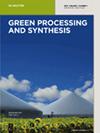Potent antibacterial nanocomposites from okra mucilage/chitosan/silver nanoparticles for multidrug-resistant Salmonella Typhimurium eradication
IF 3.8
4区 工程技术
Q2 CHEMISTRY, MULTIDISCIPLINARY
引用次数: 0
Abstract
The polymeric nanocomposites (NCs), constructed from okra (Abelmoschus esculentus) fruits mucilage (OM), silver nanoparticles (AgNPs), and chitosan (Ch), were fabricated as potential candidates to overcome drug-resistant Salmonella Typhimurium bacteria. AgNPs were directly mediated by OM, with 4.2 nm mean diameters. The composed NCs from Ch/OM/AgNPs were innovatively synthesized and the various ratios of Ch:OM/AgNPs affected the NCs particles’ size and charges. The infrared analysis of employed materials/NCs validated their interactions and conjugations. The antibacterial assays of NCs against different resistant S. Typhimurium strains indicated the efficiency of polymeric NCs to inhibit bacteria with significant superiority over standard antibiotics. The NCs that contained equal ratios from Ch and OM/AgNPs were the best formulation (mean diameter, 47.19 nm and surface charge, +16.9 mV) to exhibit the strongest actions toward S. Typhimurium. The NCs caused severe deformation, destruction, and lysis in exposed bacteria, as traced with scanning microscopy. The biosynthesis of AgNPs using OM and their nanoconjugation with Ch provided effectual natural biopolymers NCs with enhanced expected biosafety and efficiency against drug-resistant S. Typhimurium strains, which supports their potential applications as disinfectant, sterilizing, and curative antibacterial agents.利用秋葵粘液/壳聚糖/银纳米颗粒制成的强效抗菌纳米复合材料根除耐多药伤寒沙门氏菌
由秋葵(Abelmoschus esculentus)果实粘液(OM)、银纳米粒子(AgNPs)和壳聚糖(Ch)构建的聚合物纳米复合材料(NCs)被制成,可用于抑制耐药性鼠伤寒沙门氏菌。AgNPs 由 OM 直接介导,平均直径为 4.2 nm。创新性地合成了由 Ch/OM/AgNPs 组成的 NCs,Ch:OM/AgNPs 的不同比例影响了 NCs 颗粒的大小和电荷。对所用材料/NCs 的红外分析验证了它们之间的相互作用和共轭。用 NCs 对不同的耐药鼠伤寒杆菌菌株进行的抗菌试验表明,聚合物 NCs 的抑菌效果明显优于标准抗生素。含有等比例 Ch 和 OM/AgNPs 的 NCs 是最佳配方(平均直径 47.19 nm,表面电荷 +16.9 mV),对伤寒杆菌的作用最强。扫描显微镜显示,NCs 会导致暴露细菌严重变形、破坏和裂解。利用 OM 生物合成 AgNPs 并将其与 Ch 纳米共轭,提供了有效的天然生物聚合物 NCs,提高了预期的生物安全性和抗耐药性伤寒杆菌菌株的效率,从而支持其作为消毒剂、灭菌剂和治疗性抗菌剂的潜在应用。
本文章由计算机程序翻译,如有差异,请以英文原文为准。
求助全文
约1分钟内获得全文
求助全文
来源期刊

Green Processing and Synthesis
CHEMISTRY, MULTIDISCIPLINARY-ENGINEERING, CHEMICAL
CiteScore
6.70
自引率
9.30%
发文量
78
审稿时长
7 weeks
期刊介绍:
Green Processing and Synthesis is a bimonthly, peer-reviewed journal that provides up-to-date research both on fundamental as well as applied aspects of innovative green process development and chemical synthesis, giving an appropriate share to industrial views. The contributions are cutting edge, high-impact, authoritative, and provide both pros and cons of potential technologies. Green Processing and Synthesis provides a platform for scientists and engineers, especially chemists and chemical engineers, but is also open for interdisciplinary research from other areas such as physics, materials science, or catalysis.
文献相关原料
| 公司名称 | 产品信息 | 采购帮参考价格 |
|---|
 求助内容:
求助内容: 应助结果提醒方式:
应助结果提醒方式:


